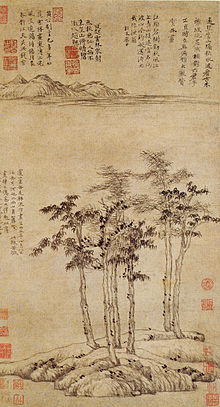- Ni Zan
-
Ni Zan (simplified Chinese: 倪瓒; traditional Chinese: 倪瓚; pinyin: Ní Zàn; Wade–Giles: Ni Tsan; 1301–1374) was a Chinese painter during the Yuan Dynasty. Along with Huang Gongwang, Wu Zhen, and Wang Meng, he is considered to be one of the four "Late Yuan" masters.
Ni Zan was born into a wealthy family in Wuxi. His style name was Yuan Zhen (元鎮). His pseudonyms were Yun Lin Zi (雲林子), Huan Xia Sheng (幻霞生), and Jing Man Min (荊蠻民).[1] He was born after the death of the Kublai Khan, the Mongolian ruler who defeated the Song and established dominance over all that had traditionally been considered China. The Yuan rulers did not trust many of the Confucian scholars and instead preferred to instill Mongolians and Muslims to perform administrative tasks. Ni Zan was born into an elite who could afford to be educated despite the unavailability of high-paying governmental jobs that traditionally were the reward for a rigorous Confucian education. These wealthy scholars and poets were often entertained by the eccentric Ni Zan and were part of a movement that radically altered the traditional conceptions of Chinese painting. Their paintings depicted representations of natural settings that were highly localized, portraying personally valued vistas that reflected their individual feelings.
During the 1340s a number of droughts and floods caused a famine throughout Ni Zan's region and subsequently lead to peasant revolts. These revolts reached a fever pitch in 1350 due to the government’s use of forced labor to repair the dikes on the Yellow River. Throughout the 1340s, the Yuan imposed oppressive taxes on the rich landowners of the region in order to cover the cost of these natural disasters. There are many divergent opinions concerning Ni Zan’s reaction to these taxes and his ensuing actions are unclear. However, it has been established that he distributed all of his possessions to his friends and moved into a houseboat. He left on the eve of the millenarianist Red Turban Revolt and traveled throughout the relatively peaceful southeast while various revolutionary parties tore through his region of origin. It was at this time that Ni Zan developed his distinctive style.
Ni Zan's landscapes after 1345 all take very much the same form - ink-monochrome painting of widely separated riverbanks rendered in sketch brushwork and foreground trees silhouetted against the expanse of water. These sparse landscapes never represent people and defy many traditional concepts of Chinese painting. Many of his works hardly represent the natural settings they were intended to depict. Indeed, Ni Zan used his art as a medium of expression. In 1364, he said “I use bamboo painting to write out the exhilaration in my breast, that is all. Why should I worry whether it shows likeness or not?”
Ni Zan traveled around southern China during the fall of the Yuan and spent his time painting. During his lifetime, his work was highly valued and it itself was enough to pay for the hospitality provided by his friends as he traveled. He returned to his hometown in 1371 after the establishment of the Ming Dynasty. It was in 1372 that he painted his Rongxi Studio, which epitomizes his style.
Contents
Paintings
Notes
- ^ Cihai: Page 253.
References
- Masterpieces of Chinese Art (page 90), by Rhonda and Jeffrey Cooper, Todtri Productions, 1997. ISBN 1-57717-060-1
- Cahill, James. Hills Beyond a River: Chinese Painting of the Yuan Dynasty: 1279-1368. New York: Weatherhill, 1976. 114-120.
- Fong, Wen C. Beyond Representation: Chinese Painting and Calligraphy 8th-14th Century. New Haven: Yale UP, 1992.
- Siren, Osvald. Chinese Painting: Leading masters and principles. Vol. IV. New York: Hacker Art Books, 1973. 79-84.
- Xin, Yan, Nie Chongzhen, Lang Shaojin, Richard M. Barnhart, James Cahill, and Wu Hung. Three Thousand Years of Chinese Painting. New Haven: Yale UP, 1997.
- Vandier-Nicolas, Nicole, Peinture chinoise et tradition lettrée, Paris : Seuil. 173-177.
- Ci hai bian ji wei yuan hui (辞海编辑委员会). Ci hai (辞海). Shanghai: Shanghai ci shu chu ban she (上海辞书出版社), 1979.
External links
- Ni Zan and his painting gallery at China Online Museum
- Met Museum
Categories:- 1301 births
- 1374 deaths
- Chinese painters
- Yuan Dynasty painters
- Ming Dynasty painters
Wikimedia Foundation. 2010.



